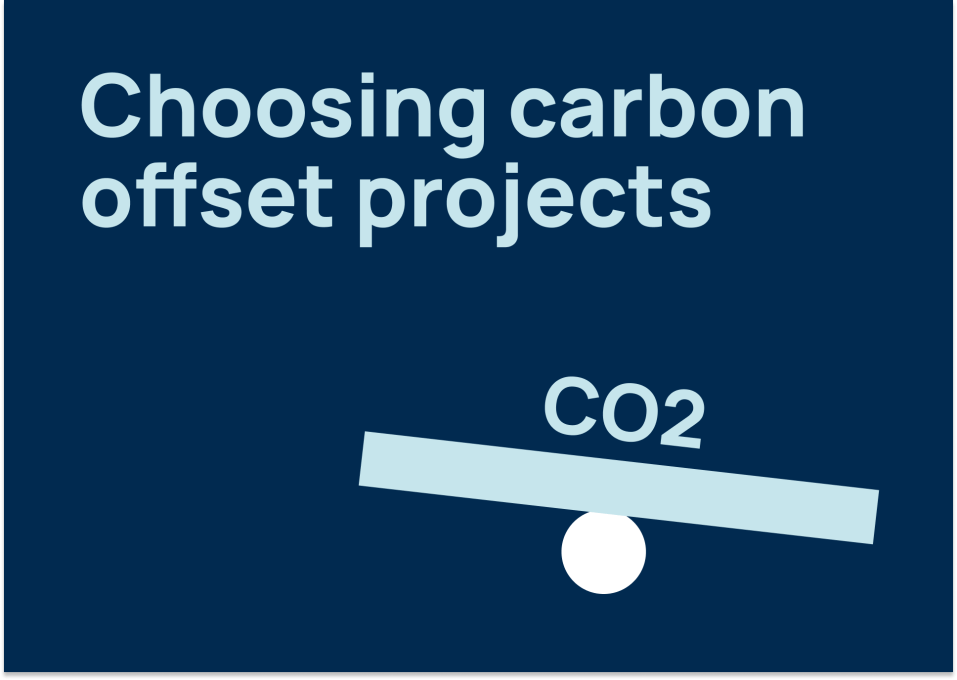Every company in our community is committed to becoming climate neutral. While most part of the year we should continuously work on emissions reduction and avoidance, we still have to offset the rest emissions annually. By calculating your carbon footprint and offsetting your carbon emissions to reach climate neutrality – both on a corporate but also on a product level – you have at hand a verified, effective means to make a notable change on the short term. But what should you know and consider when it comes to selecting the best suitable carbon offset project?
What does climate neutrality mean?
Companies and products may be called climate-neutral if their unavoidable CO2 emissions have been compensated by supporting internationally recognized carbon offset projects. This process is defined in the Kyoto Protocol as the Clean Development Mechanism (CDM) and is based on the scientific derivation that greenhouse gases such as CO2 are distributed evenly in the atmosphere. Thus, with regard to the global climate it does not matter where on earth greenhouse gas emissions are generated or saved. Therefore, emissions that cannot be avoided in an industrialized country may be compensated by carbon offset projects in developing countries.
One purpose – different technologies
Carbon offset projects reduce greenhouse gas emissions and make a significant contribution to counteracting global warming. This can be achieved through measures such as forest protection, reforestation, or the expansion of renewable energies. In addition, carbon offset projects promote sustainable development in the regions where they are located, for example by improving the supply of clean drinking water or by expanding local infrastructures, creating jobs or preserving biodiversity.

Among the various measures for climate action, those that focus on the protection of forests are becoming increasingly important. A central mechanism is known as REDD+ (Reducing Emissions from Deforestation and Degradation) initiated by the United Nations in 2008. REDD+ aims to avoid CO2 emissions associated with deforestation. Instead of making a profit from cutting trees for commercial purposes – legally or illegally – the preservation of forests becomes a new business model and also improves living conditions for the local population. In this context, preserving forests does not only contribute to reducing CO2 emissions, it also protects water bodies, stabilizes rainfall systems, and has a positive impact on biodiversity and local communities.
Standards and requirements have to be met
One of the most important requirements for carbon offset projects is that they have to be additional measures. In other words, without the financial support of companies, they could not operate. Moreover, their contribution to reducing CO2 in the atmosphere must be guaranteed in the long term and must be clearly measurable. In addition, the CO2 emissions saved and certifications generated through a project may only be used once to offset other CO2 emissions; the corresponding certificates are then retired and cannot be sold again. This is done via the official registers of the standards mentioned in the following.

In order to comply with the CDM and in addition to the general requirements mentioned above, projects also have to meet internationally recognized standards. There are several strict standards for certification and verification, for example, the "Gold Standard" or the "Verified Carbon Standard" (VCS). The emissions reduction through the projects is also monitored by independent third parties and confirmed annually in retrospect. As there is no such thing as an efficiency benchmark for carbon offset technologies, it is important to point out that all carbon offset projects that meet the above-mentioned criteria are fully effective in their own way. So, if companies want to consider technologies from an impact perspective that measures the potential level of emissions mitigation or reduction, they should look at the scale of a project rather than its technology. For example, a small afforestation or reforestation project saves less emissions per year than a large forest protection project. The same goes for renewable energy or energy efficiency projects: small hydropower plants can save up to 10,000 tCO2e/year, whereas large hydropower plants, wind or solar farms, may save more than 200,000 tCO2e/ per year. Our experience shows that the larger a project, the more cost-efficient the operation is in general. While size should be defined by an average volume of carbon emissions per year. Also, besides the impact of carbon savings, we also need to look at the social and environmental impacts of a project. The more people can be reached, and more lives can be improved, the better.

These examples show that the evaluation and selection of carbon offset projects should at best be done from several perspectives. In terms of official standardization and certification, the Gold Standard is among the leading standards to define the quality of a carbon offset project. It was developed with the participation of the WWF and 40 other NGOs and sets particularly strict requirements regarding additionality, sustainable development, and involvement of the local population. However, a project should be evaluated by more than just its standard. For instance, all projects under Verified Carbon Standard (VCS) have to meet the essential criteria for carbon offset projects including additionality, permanence, exclusion of double-counting and regular verification by independent third parties. In addition to that, they also contribute to sustainable development for the local population and ecosystems, especially those which are additionally certified by the “Climate, Community and Biodiversity Standard” (CCBS) or Social Carbon standard.
Matching your company's values
It is also important to be clear about the values a company wants to transport underline by supporting a carbon offset project. It could be a link between a company's products (e.g. apparel and textiles), the production method (e.g. farming, fishing etc.), and their respective counterparts on the project side. The better the specifics of a project match a company's values, the more authentic the engagement is and the better it can be communicated not only internally but also to the public. Of course, the price per certificate from a specific project also plays a role in making the decision. Here it is important to understand that lower project costs do not necessarily mean a lower impact or quality. In carbon offsetting, money is earmarked for a specific purpose. Unlike a donation, carbon offsetting always creates a concrete equivalent value, namely the offsetting of one ton of CO2, for that a certain price is to be paid. That price depends on the scope of the project, the funds required for the project, the project region, the technology, the certification standard, etc. Also, every carbon offset project has a specific financing requirement, which must be covered by the sale of certificates. The number of certificates is determined by the amount of CO2 savings. The price results from the underlying standard (certification effort) as well as supply and demand. Also, most projects are not exclusively financed by the sale of the certificates. It can be local organizations, initiatives, etc. that are not supported by governmental aid and therefore have to rely on external support. Thus, certificates close a financing gap without which a project could not be implemented.
DIY in climate action?
If companies wish to create their own project, they need to consider a lot of administrative tasks before starting the actual project. This includes the setup of a so-called Project Design Document (PDD) outlying the detailed calculation of emissions reductions and sustainability impacts. They also need to find partner organizations, negotiate on cooperation contracts, decide which standard the project should apply to, and many more aspects. Between the first project idea and the first issuance of carbon credits an average period of five years has to be considered. In this light, developing a project makes sense starting with a volume of 10,000 tons/year. For this, a minimum budget for prefinancing and investment would be EUR 50.000.
Companies who chose to build their own projects mainly do this because of a strong brand positioning that allows them to have control over all aspects of communication and marketing. They are able to control and manage things directly. Some also want to use it to secure long-term coverage of their need for emission certificates. However, it is rather obvious that companies are not the experts here. They would at least need expert assistance in understanding what to do, where to start and how to approach local communities and partners.
Counting the good – measuring the impact
A globally recognized benchmark for measuring and tracking the effects of projects is set by the 17 UN Sustainable Development Goals (SDGs). They range from the fight against poverty and hunger, improving education or creating jobs to the dissemination of clean and affordable energy. Offsetting providers prefer to choose for their portfolio only projects that contribute to several of these goals.

Finally, the actual emissions reductions through a project have to be constantly monitored and regularly verified by independent third parties, such as TÜV, SGS, etc. Only after this verification, the emission reduction certificates may be issued and sold on the market. Monitoring and verification reports are published on the public registries’ websites. Recently, the Gold Standard or Verra (for VCS projects) have started to certify the SDG-related impacts (besides SDG 13), so that, for instance, certificates may also be purchased for health credits.
Despite Corona pandemic: our projects continue
Especially in times of the global corona pandemic, it is important that Carbon offset projects continue. In addition to reducing carbon emissions, they often improve local health care and sanitary conditions, like for instance, ClimatePartner´s clean drinking water project in Uganda. By distributing water filters it replaces the need to boil water for disinfection. This would usually happen over an open fire and causes high levels of air pollution, carbon emissions, and the loss of precious forests. In addition, it enables the local population to use clean water for nutrition and personal care, which is one of the key hygiene rules in the fight against the spread of the coronavirus and other pathogens. This way, the project contributes to climate protection and improves hygiene for the local communities.
Organizations like the WWF have confirmed the importance of carbon offset projects for global health. In early April, the organization published an analysis on the growing health risks due to the destruction of the environment: in contributing to the protection of ecosystems, carbon offset projects reduce the pressure on wild animals, which means they also reduce the risk of transmitting harmful germs or viruses from animals to humans.
Conclusion
When aiming for climate neutrality, carbon offset projects are an important means for balancing and compensating emissions. Ideally, it has to be embedded in a holistic strategy for corporate climate action that also draws on emissions reduction and avoidance. Here, companies best seek support by an experienced partner who has the know-how to collect and assess emissions data for setting up a carbon footprint, to draw conclusions for a thoughtful and holistic climate action strategy and finally has the access to certified, effective carbon offset projects that support both the company's vision and value and make a meaningful contribution to counteract on climate change.


